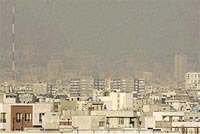Discover a new source of atmospheric pollution

Fog in Tehran in December 2005
According to Nature, European researchers have discovered a source of pollution so far unknown that releases nitrogen acid, a gas that contributes to the fog on sunny cities. .
When light is present, azote dioxide (derived from the combustion of car engines, thermal power plants and heating systems) reacts with moisture, organic compounds decompose into humus, to create this pollutant gas. Humidity comes from the decomposition of organic matter that is present everywhere on the Earth's surface, whether it is the natural environment or the areas severely affected by humans.
According to researchers at the Wuppertal University (Germany), Paul Scherrer Institute (Switzerland) and Villeurbanne Environmental Chemistry Laboratory (France), the production of excess nitrogen can work Serious action to the troposphere, the lowest, most dense and most polluted layer of the atmosphere.
It has been known for 20 years that nitrous acid decomposition by light releases hydroxyle radicals that affect ozone production cycles. The phenomenon of excess nitrogen acid production may cause half of the hydroxyle roots.
Unlike stratospheric ozone in high atmospheric layers that benefit from filtering ultraviolet rays emitted from the Sun, ozone in the lower atmosphere is a major source of air pollution. It contributes to the bright yellow photochemical smog, which stimulates the mucous membranes, eyes, and respiratory tract and often occurs in sunny cities.
- The greenhouse effect slows down due to atmospheric pollution
- Avoid indoor air pollution
- Alarm of water pollution in HCMC
- Encourage the manufacture of solar vehicles
- Discover the source of the dream
- Measure the atmospheric composition to find life in Mars
- When the ocean speaks:
- The water has strange colors in China
- Video: The atmospheric river causes 43 days of continuous rain in the United States
- Air pollution causes 7 million deaths
- Ho Chi Minh City: Pollution threatens tap water
- 'River in the sky' can cause floods to destroy species
 Is the magnetic North Pole shift dangerous to humanity?
Is the magnetic North Pole shift dangerous to humanity? Washington legalizes the recycling of human bodies into fertilizer
Washington legalizes the recycling of human bodies into fertilizer Lightning stone - the mysterious guest
Lightning stone - the mysterious guest Stunned by the mysterious sunset, strange appearance
Stunned by the mysterious sunset, strange appearance